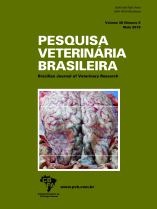 |
|
|
|
Year 2018 - Volume 38, Number 5
|

|
Parasitic profiling of Japanese quails (Coturnix japonica) on two farms with conventional production system in the Amazon region, 38(5):847-851
|
ABSTRACT.- Monte G.L.S., Cavalcante D.G. & Oliveira J.B.S. 2018. Parasitic profiling of Japanese quails (Coturnix japonica) on two farms with conventional production system in the Amazon region. [Perfil parasitário de codornas (Coturnix japonica) em duas granjas com sistema convencional de produção na Amazônia.] Pesquisa Veterinária Brasileira 38(5):847-851. Laboratório de Entomologia e Vetores de Doenças Tropicais, Instituto Nacional de Pesquisas da Amazônia, Cx. Postal 478, Coroado, Manaus, AM 69011-970, Brazil. E-mail: gersonval.monte@inpa.gov.br
The health monitoring and management systems of coturniculture can be deemed to be in a developmental phase when compared to the poultry industry. Studies regarding taxonomy and parasitic biology in quails (Coturnix japonica) has not been well conducted in Brazil. Most of the information is available from the autopsy case reports, in many ways the parasitic fauna of quails is still unknown. The aim of this study was to conduct a parasitological research in quails in order to contribute to ameliorate this situation. 31 quails, which were 12 months old, were used for the study. Their carcasses and viscera were sent to the Laboratory of Entomology and Tropical Diseases, INPA, Manaus/AM. The circulatory, nervous, respiratory, digestive and reproductive systems of these were studied separately. No blood parasites were found, however, nine species of endoparasites were registered which were distributed among the classes Cestoda, Nematoda and Protozoa. The helminths were distributed in the duodenum, jejunum, ileum, cecum and oviduct. The cecum was found to be the most parasitized organ and contained a wide range of parasites having three species of protozoa and three species of nematodes. Six morphotypes of Eutrichomastix globosus were recorded, and some morphotypes were hyperparasitized with sporangia Sphaerita sp. in the cytoplasm. A large number of parasites were recorded in this study, as well as the protozoan Blastocystis hominis was first being observed for quail. |
| |
|
|
| |
|
 |